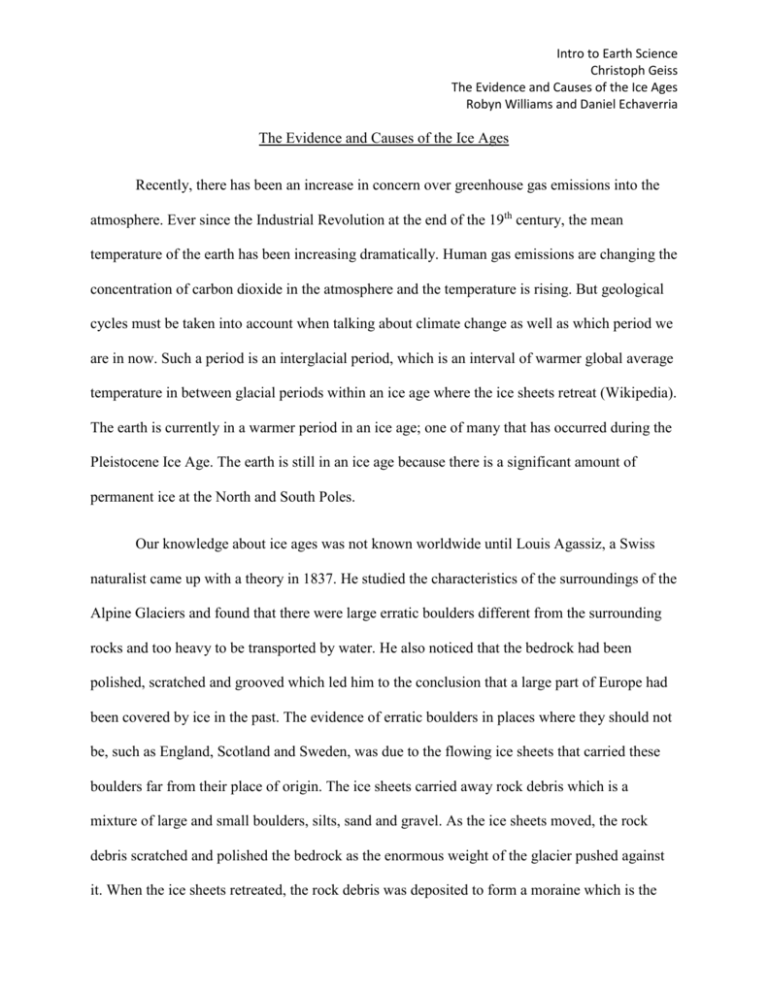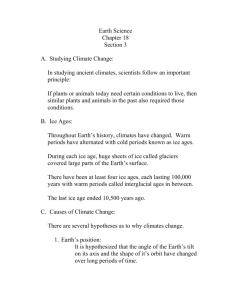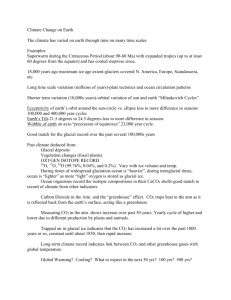The Evidence and Causes of the Ice Ages
advertisement

Intro to Earth Science Christoph Geiss The Evidence and Causes of the Ice Ages Robyn Williams and Daniel Echaverria The Evidence and Causes of the Ice Ages Recently, there has been an increase in concern over greenhouse gas emissions into the atmosphere. Ever since the Industrial Revolution at the end of the 19th century, the mean temperature of the earth has been increasing dramatically. Human gas emissions are changing the concentration of carbon dioxide in the atmosphere and the temperature is rising. But geological cycles must be taken into account when talking about climate change as well as which period we are in now. Such a period is an interglacial period, which is an interval of warmer global average temperature in between glacial periods within an ice age where the ice sheets retreat (Wikipedia). The earth is currently in a warmer period in an ice age; one of many that has occurred during the Pleistocene Ice Age. The earth is still in an ice age because there is a significant amount of permanent ice at the North and South Poles. Our knowledge about ice ages was not known worldwide until Louis Agassiz, a Swiss naturalist came up with a theory in 1837. He studied the characteristics of the surroundings of the Alpine Glaciers and found that there were large erratic boulders different from the surrounding rocks and too heavy to be transported by water. He also noticed that the bedrock had been polished, scratched and grooved which led him to the conclusion that a large part of Europe had been covered by ice in the past. The evidence of erratic boulders in places where they should not be, such as England, Scotland and Sweden, was due to the flowing ice sheets that carried these boulders far from their place of origin. The ice sheets carried away rock debris which is a mixture of large and small boulders, silts, sand and gravel. As the ice sheets moved, the rock debris scratched and polished the bedrock as the enormous weight of the glacier pushed against it. When the ice sheets retreated, the rock debris was deposited to form a moraine which is the unconsolidated glacial debris (Frozen Earth, 49). After Agassiz published his theory, evidence for Ice ages appeared all over the world. Similar characteristics to the ones Agassiz found were discovered in North America, and many other countries in Europe which allowed geologist to map the extent of the glaciers. In their maximum extent, ice sheets covered a large part of Europe, North America, United Kingdom, Germany, Sweden, Norway and the whole of Canada and the north of the United States. Further observations in sedimentary deposits in lakes allowed geologists to confirm that there have been warmer and colder periods within the Ice Age. Glacial lakes contain a type of sediment called “varves”. The main feature of this sediment is that it contains a pattern of recurring, well separated layers. The varves contain a layer of with relatively coarse silty material and a layer of very fine grains (Frozen Earth, 58). During the summer, the melted water flows through the glacier and carries part of the rock debris with it. The bigger grains sink to the bottom and the finest grains remain suspended. During winter when the lake is frozen, there is no supply for new sediments and the wind cannot move the water downstream. Therefore the fine particles slowly sink and remain on top of the coarser grained layer. When the transport melts, the ice sheets moved, the larger pebbles are dropped in amongst the fine grained sediments. The varves relate to the ice ages because the presence of relatively large stones and pebbles in the fine grained layer do not seem to fit into the composition of the layer (Frozen Earth, 59). This indicates that the ice advanced and retreated several times and gives evidence to support glacial and interglacial periods. With enough geological evidence of an Ice Age and warmer and colder periods within the Ice Age, the scientific community wanted to establish the causes. The major concern was to establish what cyclical phenomenon causes part of the earth to freeze and defrost. Geologists and Scientists attention moved to Scotland when a Scottish scientist, James Croll, developed a theory linking ice ages to the changes of the earth’s orbit. Croll came out with his theory during the 1860’s (Frozen Earth 81). The changes of the earth’s orbit had been established by this time, but had not been linked to the ice ages. The sun’s radiation plays a big role in the earth’s climate since the earth is directly heated by the sun. When the patterns of the earth`s orbit change, the energy received from the sun also changes. Eccentricity, precession and obliquity are three different ways in which the earth moves around the sun. Eccentricity occurs every 100,000 years and is the steady change of the earth’s orbit from a circular to an elliptical shape (Frozen Earth 76-77 and Portraits of a Planet G5). Precession occurs every 23,000 years and is the “wobble” of the earth on its axis (Frozen Earth 79 and Portraits of a Planet G16). Obliquity or tilt occurs every 41,000 years and is when the earth tilts on its axis so that parts of the earth are further away from the sun making them colder (Frozen Earth 79). These cycles were later renamed to the Milankovitch Cycles. James Croll took into consideration the precession and the eccentricity to explain the causes of the ice ages. The problem with his theory was that he predicted part of the hemispheres would be covered with ice alternately every 11,500 years, which represents half of the precession cycle. These glacial episodes would only occur when the eccentricity is at its maximum. Since eccentricity is longer than the precession cycle, it would allow some glacial and interglacial periods. Croll estimated that the last glacial period occurred about 80,000 years ago and although his theory was well structured and presented a possible reason for the ice ages to occur it was proven to be inaccurate (Frozen Earth 81-83). Since modern dating techniques did not exist, geologists measured erosion rates in glacial drifts and determined that the last glacial episode occurred 10,000 years ago, a number that did not match with Croll’s estimation. Therefore, his theory lost acceptance among the scientific community. Some years later in the 1940`s, a Serbian mathematician reviewed James Croll`s ideas and refined his theory. The first step made by Milutin Milankovitch was to include the tilt or the obliquity in his calculations. He then calculated how these three cycles correlate. In his results, the 100-year eccentricity cycle seemed to be the one that drove the glacial and interglacial cycles. The other two cycles, the 41,000 year-cycle and the 23,000 year-cycle, also made small changes in the amount of energy received from the sun. The Milankovitch theory was debated for a long time until scientists compared the Milankovitch calculations with the ratio of oxygen isotopes found in marine shells. There are two types of oxygen isotopes: O18 and O16. O18 is heavier and remains in oceans while O16 is lighter and evaporates more easily, accumulating in clouds and falling as snow in glaciers. Shellfish use oxygen to build their shells, and by studying the composition of these shells, it can show the ratio of the isotopes. If the shells contain a large number of O18, there was a large volume of water removed from the oceans and stored as glaciers. If the shell contains both O16 and O18, the period was slightly warmer and not as much water was stored as glaciers. When scientists determined the temperature for the past one million years by using the oxygen isotope technique, the results were very similar with those calculated by Milankovitch. Every 100,000 years a glacial period occurred as well as an interglacial period every 100,000 years. But when measurements go further back, until about 2.5 million years ago it seems that the 41,000 year cycle drives the interglacial and glacial periods. It is evident that the changes in the Earth’s orbit drive the climate of the Earth. Analysis of glacial drifts, varves and scratched bedrock helped scientists to identify four major ice ages, but the evidence is hard to interpret and therefore they are not 100% precise. The main reason for which these Ice Ages occur is still a topic of controversy. But most scientists agree that it must be a combination of several factors. The Milanovitch cycles control the solar energy received by the Earth, but that must be amplified in order to enter an ice age. The albedo, the way light from the sun is reflected, increases the amount of solar radiation sent back to the space. The relative position of the continents can change the ocean currents which can modify the heat distribution. For example, if the Gulf current stopped, the climate in Europe would be colder than it is today. The amount of carbon dioxide in the atmosphere can also determine the temperature because there is a strong correlation between the amount of carbon dioxide and the temperature of the earth. Large amounts of carbon dioxide are discharged by volcanoes and the process by which the carbon dioxide is removed from the atmosphere plays an important role. This process is the long term carbon cycle (Climate 31). The rainwater removes the carbon dioxide from the atmosphere and the carbon then cycles under the ocean floor through sea floor spreading and convergence. At a convergence margin, volcanoes release more carbon dioxide into the atmosphere where it is absorbed again by the rain clouds and the cycle is repeated (Climate 31). Geologists and scientist have managed to identify the causes of the ice ages by observing the geological processes of the earth and connecting them all together. From the early 1800’s with Louis Agassiz and James Croll in the latter part that century to Milutin Milankovitch in the 1940’s, scientists have built on one another’s theory about the causes of the ice ages and their evidence to support it. As technology increased they discovered more about the way the earth’s processes worked and linked them all together to better understand the causes of the ice ages. Recently technology has allowed scientists to measure the amount of carbon dioxide in the atmosphere on a regular basis. The results have shown an increase in the amount of carbon dioxide in the atmosphere and this has caused great alarm within the general public about global warming. But one must take into consideration that the earth is coming out of an ice age and moving into a warmer period, therefore the amount of carbon dioxide will increase slowly. Unfortunately man made pollution and the increase in technology, releases more amounts of carbon dioxide than is natural and therefore is speeding up the warming of the earth. This can be a can be a cause for concern. References George Ochoa, Jennifer Hoffman, Tina Tin. Climate, the force that shapes our world and the future of life on earth. n.d. Pgs 30-31 Macdougall, J. Frozen Earth. Berkeley University of California, 2004. Pgs 49,58,77,78,83,85,87, Wikipedia- http://en.wikipedia.org/wiki/Interglacial. Marshak, Stephen. Portraits of a Planet. Glossary and terms. Pg 714-718 *please not that this is incomplete and will be added in to the text in the next draft.









